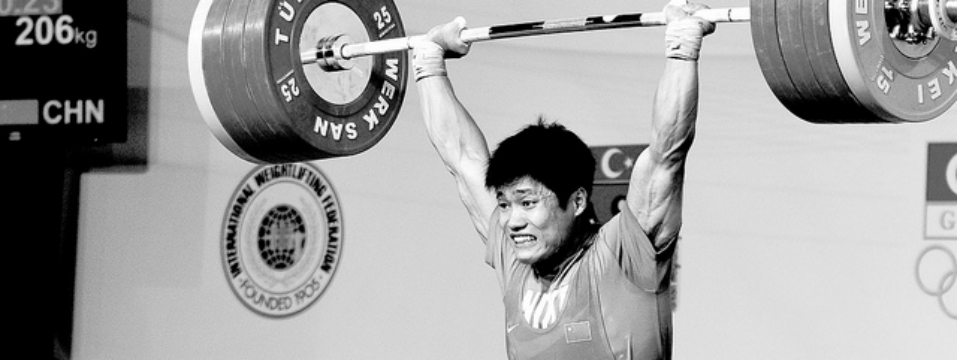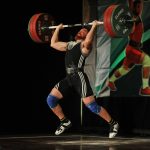By: Adam Sayih
Great, another New Year’s Resolution article. Chances are you’ve already spent quite some time under the barbell, so the new year serves more as a time to assess how you’re going to handle the next training year rather than signing up for your first gym membership. If training has been stale lately or you just want to take lifting to the next level, consider these tips.
1. Sign up for a competition

Whether it’s Olympic weightlifting, power-lifting, strongman, etc., sign up for something! Registering for a competition will not only increase your training motivation by tenfold, but also hold you accountable for all the variables of peaking performance such as proper nutrition, sleep, monitoring volume and intensity. Never competed before? Don’t stress it. Too often people hold back registering for competitions because they feel they aren’t “ready.” This statement is extremely relative and every competition will give you something to learn from. The Olympics wasn’t Lu Xiaojun’s first rodeo. Every competition will provide you with experience and will only fuel your motivation for the next competition.
2. sleep more
Sleep is without a doubt the best recovery tool for strength athletes. Ideally, athletes need 8-9 hours of sleep for optimal performance and recovery. A study published in the Journal of the Institute of Ergonomics and Human Factors showed that athlete participants who slept for only three hours for three successive nights had significant declines in bench press, leg press, and deadlift performance as a result of the little amount of sleep [1]. It’s understandable that some of us live busy lives, but there are habits we can avoid to increase the amount of sleep we get such as late night internet habits and caffeine late in the day.
3. stick to a program
Today’s world wants instant results. People would rather dream of a magic pill that will make them shredded overnight and add 100 pounds to their squat overnight than actually bust their ass in the gym to acquire said goal. Time to wake up. In the words of Rob Orlando: “Strength takes a lifetime to acquire.” Too often young strength athletes will hop around program to program when they hear about the next great program. When I first started taking lifting seriously, I did Jim Wendler’s 5/3/1 program for literally a year and a half. Every once in awhile I’d asked my mentor at the time about another program I’d heard about and if I should try it and he would say “is 5/3/1 still working? If it’s not broken don’t fix it.” Programs work, period. But they only work if performed in the way they’re designed. Pick something that’s specific to your goals and have at it. Be patient and give the program a chance to work its magic.
4. more grip work

It goes without debate that the stronger your grip, the more weight you can move. Generally, your grip will keep up with the rest your lifts, however, additional grip work will do wonders to strength work. With stronger grip you can manhandle weights with less effort which makes the exercise less taxing and will allow you to increase your work capacity. For example, someone with better grip will probably be able to crank out a few more reps on a deadlift set as opposed to someone with a weaker grip.
Improving your grip doesn’t have to be complicated. Just hold onto anything for a long time. Some of my favorite methods are:
Farmer’s Walk: Grab two dumbbells and just walk. I generally like to go till failure and add weight every set.
Plate Pinches: Pinch a plate using one hand. I like to do this at the end of a workout when I put the plates away.
Double-overhand Deadlift holds: Load up 60% of your deadlift max. Using a double-overhand grip (not mixed, no hook, no straps), perform one rep and just hang out at the top as long as you possibly can.
5. build a stronger back
Chances are you aren’t doing enough pulling. A stronger back means a stronger everything. If you can’t crank out at least 10 pull-ups (body weight isn’t an excuse), get to work. Having a strong back will keep you in the correct (and safe) positions in every compound lift including squats, deadlifts, and the Olympic lifts. The muscles of the back literally support spinal position. Most people who don’t do enough pulling exercises also encounter imbalances. This leads to problems such as shoulder pain or bad posture.
My favorite back specific exercises include dumbbell rows, Pendlay barbell rows and pull-ups. Do them often and hit them hard!
Also these are pretty intense.
6. strengthen your abs
Crunches are pretty much useless. The problem with most people who do abdominal exercises is that they typically do movements that have little to no resistance for a gabillion reps because it “burns.” Strength comes from an overload, meaning you’re doing enough resistance that your muscles need to make an adaptation (aka get stronger). A burn on the other hand is just an end-product of glycolysis.
Actually strengthening the abs will result in better positioning in the big lifts, as in less rounding over or a dumping torso. To strengthen the abs you need to treat the abdominal muscles just like every other muscle; challenge them, don’t burn them. My favorites include barbell roll-outs and dragon flag progressions (I suck too much to do actual dragon flags).
http://www.youtube.com/watch?v=CavZeuCS56g
7. increase your mobility
The struggle is definitely real when it comes to mobility. A conscious effort should be made daily to improve mobility. If you can’t get to proper positions during lifts, how can you progress? The good thing about mobility work is that there is rarely such a thing as a bad stretch. There are tons of videos and articles on how to improve mobility for various issues. If you don’t have a dedicated warm-up to work mobility and flexibility, a good start is Joe DeFranco’s Limber Eleven. I’ve been doing this whole routine roughly three times a week since the video came out and I can say I’ve had huge improvements in my flexibility and mobility which has led to much more efficient positions in all my lifts.
8. add power exercises
Basic power movements have a remarkable carry over to all lifts. The biggest benefit of power movements is that there is acceleration throughout the whole lift and you’re continually producing more force throughout the movement. This also teaches you to be more explosive in the big lifts. Keep it simple and keep the reps low. I personally like to pick a movement that’s specific to the training session and perform after my warm up.
Some examples:
Lower body session, pick one:
Jump Squats, Box Jumps, Broad Jumps Depth Jumps. 4×3
Upper body session, pick one:
Dynamic Push-ups to low box, Overhead Slams, Backwards Med Ball Throw, Med Ball Throw From Chest. 4×3
9. Squat More often
Chances are you probably can’t name an elite lifter (in any strength sport) that squats just once a week. The whole myth of “one body part per week” is a bunch of garbage and if you need six days to recover, you seriously need to reassess your recovery protocols. If you go from squatting once per week to twice per week, you just went from squatting four times per month to eight times per month and from squatting 52 times per year to 104 times per year. Who do you think will be stronger? How you choose to vary your squat intensity and volume will take some time to figure out and vary depending on your goals but here are some successful examples of weekly squat layouts:
Texas Method:
Monday-Volume Day, Wednesday-Light Day, Friday-Max Effort Day
Westside Barbell:
Day 1- Max Effort Day, Day 2- Dynamic Effort Day (Explosive)
putting it all together
As lame as New Year’s Resolutions are, it doesn’t hurt to do a training analysis. No one has training down to a perfect science and it takes constant altering to goals and weakness. Play around with some of these variables and take 2014 to a whole new level of strong. Happy New Year, Classy Meatheads.
Cheers,
Adam
Stay connected!
Follow us on Instagram: @GentlemanAndMeathead
Like us on Facebook: https://www.facebook.com/GentlemanandMeathead
Follow us on Twitter: @classymeathead
References:
1. Reilly, T., & Piercy, M. (1994). The effect of partial sleep deprivation on weight-lifting performance. Ergonomics, 37(1), 107-115.








